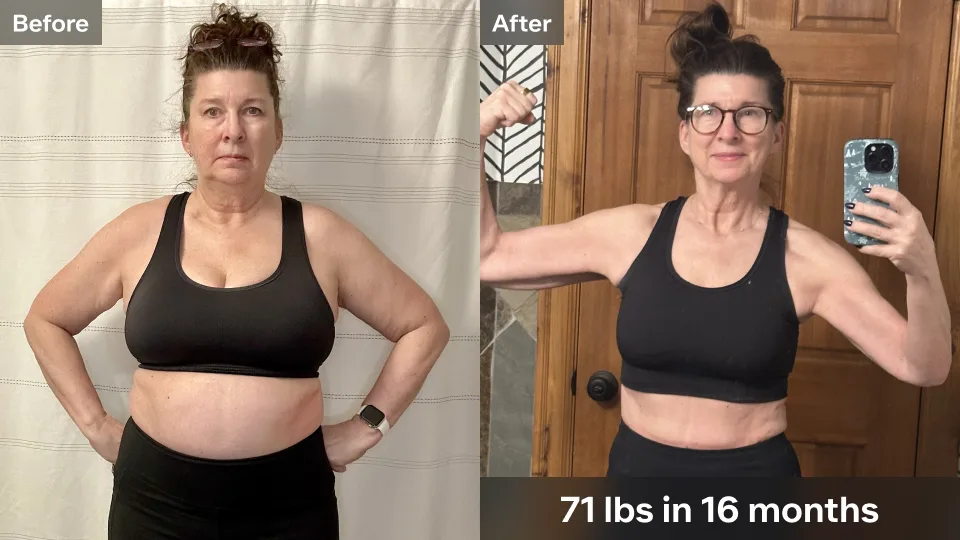BMR Calculator
Basal metabolic rate (BMR) is the amount of energy your body needs at rest to maintain vital functions, such as breathing. It can be a useful starting point for setting weight loss or nutrition goals. Use the tool below to calculate yours.

0
Cal Daily
What is BMR?
Basal metabolic rate (BMR) is the number of calories your body burns just to stay alive — even if you remain in bed all day. It reflects the minimum amount of energy needed to power your most basic bodily functions, including:
Breathing
Circulating blood
Regulating body temperature
Think of BMR as your body’s baseline energy requirement. It accounts for the largest portion of your total daily energy expenditure (TDEE), typically around 60%--70% in sedentary adults. That means even before you factor in exercise, walking, or digesting food, your body is already working hard behind the scenes.
Several key factors influence your BMR:
Body composition (fat and muscle mass): Muscle tissue requires more energy than fat tissue. So, the more lean muscle mass you have, the higher your BMR.
Body size (height and weight): Larger bodies, whether due to greater height, weight, or both, require more energy to maintain basic functions.
Age: BMR naturally declines as you get older. This is mainly due to a gradual loss of muscle mass and changes in hormone levels that slow down metabolic activity.
Sex: On average, individuals assigned male at birth (typically, men) tend to have higher BMRs than those assigned female at birth (typically, women) because they generally have more muscle mass (thanks to higher testosterone levels) and lower body fat percentages.
Hormones: Hormone levels, especially thyroid hormones, play a significant role in regulating how quickly your body uses energy. Low thyroid activity, for example, can lower BMR, while high activity can raise it.
Genetics: Inherited traits can influence your metabolic rate, including how your body distributes muscle and fat or how efficiently it processes energy.
Understanding your BMR can be a helpful first step in tailoring a nutrition or weight management plan that fits your body’s unique energy needs. It’s also used in clinical and research settings to assess metabolic health and guide interventions, such as those for weight loss (think: helping providers determine whether you may qualify for treatments, like Zepbound or Wegovy).
How to calculate BMR
BMR is calculated using your age, sex, weight, and height. The most commonly used equations are the Harris-Benedict equation and the Mifflin-St Jeor equation. While both are widely accepted, the Mifflin-St Jeor equation is considered the more reliable and is used by most health professionals and research institutions today.
Here’s the formula:
Females: (10 X weight [kg]) + (6.25 X height [cm]) – (5 X age [years]) – 161
Males: (10 X weight [kg]) + (6.25 X height [cm]) – (5 X age [years]) + 5
So, let’s say you’re a 35-year-old woman who weighs 160 pounds (72.7 kg) and is 5 feet 6 inches (167.6 cm) tall. To calculate your BMR, your equation should look like this:
(10 × 72.7) + (6.25 × 167.6) – (5 × 35) – 161 = 1,438.5 calories per day
What is a normal BMR?
There’s no single “normal” BMR that applies to everyone. That’s because your basal metabolic rate is unique to your body and shaped by individual factors like age, sex, weight, height, muscle mass, and hormone levels.
That said, scientists have been able to determine averages. According to the original paper that developed the Mifflin-St Jeor equation, the average male has a BMR of around 1,660 calories per day, and the average female has a BMR of around 1,400 calories per day. These numbers do not include the calories your body needs to turn food into energy and to perform physical activities.
What does your BMR mean?
Your BMR tells you how many calories your body burns each day at complete rest — in other words, just to keep your heart beating, lungs breathing, and cells functioning. This number is unique to your body and influenced by factors like age, sex, weight, height, and body mass.
A higher BMR generally means your body burns more calories at rest. This often reflects a higher proportion of lean muscle mass, a larger body size, or a younger age — all of which require more energy to keep things running.
A lower BMR generally means your body needs fewer calories to perform basic functions. This is common with aging, muscle loss, or certain medical or hormonal conditions.
That said, it’s important to remember:
A high or low BMR isn’t inherently good or bad.
BMR is just one part of your overall metabolic profile.
It doesn’t directly determine how many calories you should eat, but it serves as a useful starting point for understanding your body’s energy needs.
What does your BMR not tell you?
Knowing your BMR can help you understand your body’s baseline energy needs, but it only paints part of the picture — and it definitely does not account for everything that matters when it comes to your health.
Here’s a quick breakdown of what your BMR is not telling you:
How many calories you actually burn in a day. Your TDEE includes more than just resting energy; it also accounts for physical activity, movement, digestion, and more. For most people, this adds hundreds (or even thousands) of additional calories burned on top of their BMR.
Your body composition. Two people can have the same BMR but very different amounts of fat and muscle. BMR estimates don’t distinguish between how much of your weight comes from lean mass vs. fat mass; yet, that distinction plays a major role in how your metabolism functions.
Your nutritional needs. BMR doesn’t tell you how many grams of protein, carbohydrates, or fat you should eat or whether you're getting enough vitamins, fiber, or hydration. It simply estimates your resting calorie burn, not the quality of what your body needs to function well.
Whether you're gaining, losing, or maintaining weight. BMR doesn’t predict weight changes on its own. Weight change depends on your full energy balance: how many calories you take in vs. how many you burn in total.
Your overall health status. BMR doesn’t measure metabolic health, hormonal balance, insulin sensitivity, or chronic conditions that may impact your energy use. It’s one piece of your metabolic profile — not the full story.
How to use BMR for weight loss
Your BMR can be a helpful starting point for creating a sustainable weight loss plan. That’s because it tells you the minimum number of calories your body burns at rest. Once you know that number, you can figure out how many calories you burn in a typical day, then adjust your intake to support fat and overall weight loss.
Here’s how it works:
Start with your BMR. This gives you your resting calorie burn.
Calculate your TDEE. Multiply your BMR by an activity factor (based on how active you are each day) to estimate how many calories you burn in a full day, including exercise and movement. (But don’t worry — you don’t have to do the math yourself. You can use Ro’s handy TDEE calculator.)
Create a calorie deficit. To lose weight, you need to consistently burn more calories than you consume. One way you can do this is by reducing your caloric intake. In general, experts recommend a deficit of 500–750 calories per day to support a safe and steady weight loss of about 1–1.5 pounds per week (~4 pounds per month). That being said, everyone is different and working with a healthcare provider is your best bet for determining a safe and effective calorie deficit for you and your goals.
It’s important to note that your body adapts during weight loss. As you lose weight, your BMR may decrease slightly, meaning your calorie needs could shift over time. That’s why it can help to recalculate your BMR (and, thus, TDEE) every few months if you’re actively losing weight.
And remember: Calorie counting isn’t the only strategy. You can boost your BMR and, in turn, help promote weight loss (albeit modestly) through other simple strategies, such as:
Regularly exercising. Strength training, in particular, helps build muscle mass, which is known to raise your BMR and, in turn, help you lose weight.
Staying hydrated. Drinking cold water and other zero- or low-calorie beverages may temporarily increase your BMR, thereby slightly increasing your TDEE and supporting weight loss.
BMR vs. RMR
BMR and resting metabolic rate (RMR) are often used interchangeably, but they’re slightly different.
BMR is a strict measurement of how many calories your body burns at complete rest. It’s typically measured under tightly controlled lab conditions after a period of sleep and a 12-hour fast, without any recent physical activity or emotional stress.
RMR is a more flexible estimate of your resting energy needs that also accounts for low-effort daily activities (e.g. eating) in addition to basic bodily functions. It’s typically measured in less restrictive conditions, such as after a short fast and with minimal physical activity beforehand.
References
Çıtar Dazıroğlu, M. E., & Acar Tek, N. (2023). Water Consumption: Effect on Energy Expenditure and Body Weight Management. Current obesity reports, 12(2), 99–107. doi: 10.1007/s13679-023-00501-8. Retrieved from https://pubmed.ncbi.nlm.nih.gov/37036559/
Compher, C., Frankenfield, D., Keim, N., Roth-Yousey, L., & Evidence Analysis Working Group (2006). Best practice methods to apply to measurement of resting metabolic rate in adults: a systematic review. Journal of the American Dietetic Association, 106(6), 881–903. doi:10.1016/j.jada.2006.02.009. Retrieved from https://www.jandonline.org/article/S0002-8223(06)00146-5/abstract
Hall, K. D., Heymsfield, S. B., Kemnitz, J. W., Klein, S., Schoeller, D. A., & Speakman, J. R. (2012). Energy balance and its components: implications for body weight regulation. The American journal of clinical nutrition, 95(4), 989–994. doi:10.3945/ajcn.112.036350. Retrieved from https://www.sciencedirect.com/science/article/pii/S0002916523027570
Heymsfield, S. B., Gonzalez, M. C., Shen, W., Redman, L., & Thomas, D. (2014). Weight loss composition is one-fourth fat-free mass: a critical review and critique of this widely cited rule. Obesity reviews : an official journal of the International Association for the Study of Obesity, 15(4), 310–321. doi:10.1111/obr.12143. Retrieved from https://onlinelibrary.wiley.com/doi/10.1111/obr.12143
Johnstone, A. M., Murison, S. D., Duncan, J. S., Rance, K. A., & Speakman, J. R. (2005). Factors influencing variation in basal metabolic rate include fat-free mass, fat mass, age, and circulating thyroxine but not sex, circulating leptin, or triiodothyronine. The American journal of clinical nutrition, 82(5), 941–948. doi:10.1093/ajcn/82.5.941. Retrieved from https://www.sciencedirect.com/science/article/pii/S0002916523296744
Medscape. (2020). Mifflin-St Jeor Equation. Retrieved from https://reference.medscape.com/calculator/846/mifflin-st-jeor-equatio
Mullur, R., Liu, Y. Y., & Brent, G. A. (2014). Thyroid hormone regulation of metabolism. Physiological reviews, 94(2), 355–382. doi:10.1152/physrev.00030.2013. Retrieved from https://pmc.ncbi.nlm.nih.gov/articles/PMC4044302/
Parmar, R. M. & Can, A. S. (2023). Physiology, Appetite And Weight Regulation. StatPearls. Retrieved from https://www.ncbi.nlm.nih.gov/books/NBK574539/
Pethusamy, K., Gupta, A., & Yadav, R. (2022). Basal Metabolic Rate (BMR). Springer eBooks, 620–621. doi:10.1007/978-3-319-55065-7_1429. Retrieved from https://link.springer.com/rwe/10.1007/978-3-319-47829-6_1429-1
Petridou, A., Siopi, A., & Mougios, V. (2019). Exercise in the management of obesity. Metabolism: clinical and experimental, 92, 163–169. doi: 10.1016/j.metabol.2018.10.009. Retrieved from https://pubmed.ncbi.nlm.nih.gov/30385379/
Pontzer, H., Yamada, Y., Sagayama, H., Ainslie, P. N., Andersen, L. F., Anderson, L. J., Arab, L., Baddou, I., Bedu-Addo, K., Blaak, E. E., Blanc, S., Bonomi, A. G., Bouten, C. V. C., Bovet, P., Buchowski, M. S., Butte, N. F., Camps, S. G., Close, G. L., Cooper, J. A., Cooper, R., … IAEA DLW Database Consortium (2021). Daily energy expenditure through the human life course. Science (New York, N.Y.), 373(6556), 808–812. doi:10.1126/science.abe5017. Retrieved from https://www.science.org/doi/10.1126/science.abe5017
Popson, M. S., Dimri, M., & Borger, J. (2023). Biochemistry, Heat and Calories. StatPearls. Retrieved from https://www.ncbi.nlm.nih.gov/books/NBK538294/
Sabounchi, N. S., Rahmandad, H., & Ammerman, A. (2013). Best-fitting prediction equations for basal metabolic rate: informing obesity interventions in diverse populations. International journal of obesity (2005), 37(10), 1364–1370. doi:10.1038/ijo.2012.218. Retrieved from https://pmc.ncbi.nlm.nih.gov/articles/PMC4278349/
Meet our expert
When it comes to weight loss, biology is your nemesis. Not willpower. Our very own Dr. Steve explains why.
Thousands of members and counting
Real members, real weight loss results
Don't just take it from us—our members see (and feel) the difference. These members were paid in exchange for their testimonials.
87% have seen life-changing results*
93% agree Ro is easier to incorporate into their lives*
97% report silenced or quieter food noise since starting*
Average weight loss in 1 year is 15-20% (vs 2.4-3.1% with diet and exercise alone). Based on studies of branded medications in non-diabetics with obesity, or with overweight plus a weight-related condition, with diet and exercise.
*Based on survey results of 1,243 Ro members taking GLP-1 medication for at least 7 weeks, paired with diet and exercise.
A full suite of GLP-1 weight loss medications
Ozempic is FDA-approved for type 2 diabetes treatment, but may be prescribed off-label for weight loss at a healthcare provider’s discretion.






